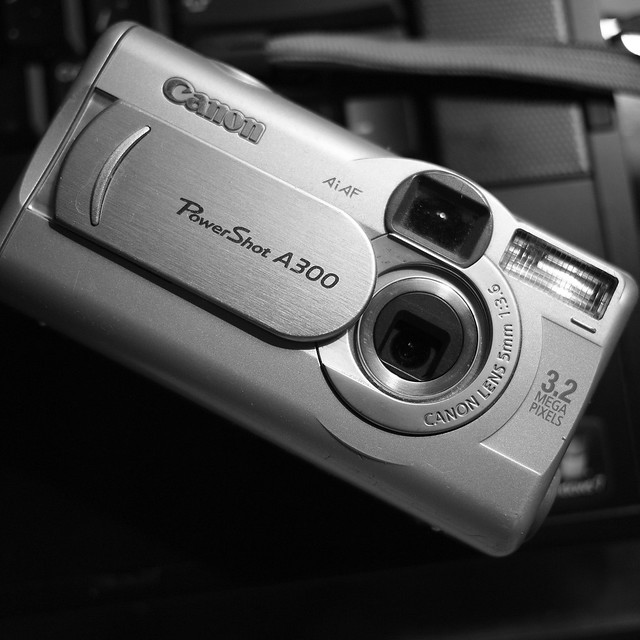My First Digital Camera
What you're looking at is my first digital camera. It was my wife's idea for me to get it. I had a Nikon N90 with a Nikkor kit zoom and Nikon flash at the time (which I gave to my #2 daughter for her college film photography classes). But it had been nearly a year since I'd bothered to pick the Nikon up and use it; it was sitting on the shelf in my closet gathering dust. Then, for Valentine's day 2004, Target had a sale where they dropped the price of this particular camera to under $200, and at the same time they cut the price on a small Canon printer that printed 4x5 prints for roughly the same price as the A300. They threw in a pack of extra paper for free. My wife read about the deal in the Sunday paper and told me to go get it.
I was ambivalent about buying such a simple point-and-shoot. I told my beloved it wasn't nearly as good as the awesome Nikon, but she responded that the little Canon would be better because at least it would be used, at least for a little while. I'd either get back into photography or else get bored again. And if that happened it was cheap enough for me to give to one of the girls.
So I bought it, and read the manual, and started to play around with it. After 30 minutes I was hooked. Not just because of the photographic results, but it's technical specs appealed to my geeky nature. For example, I could pull the Sandisk CF card I'd bought with it (a monumental 128MB) and stick it into the same sized slot on my Dell Axim 5 PDA (remember those?), and review the JPEGs on the Axim's much larger screen. It was that connection that killed any idea of printing for me. I still have the printer in its original box, along with the unused extra paper. That was eight years ago.
It's funny to look at the specifications now and compare it to what I currently use. Funny thing is that the E-1 is the same vintage as the A300, both having been released in 2003. The A300 had some interesting features that have been dropped in the name of progress. For example, it ran quite well on a pair of AA batteries. Nothing to charge, no special battery pack. It has a fixed focal length lens of 5mm, equivalent to somewhere between 28mm and 35mm. It's ISO range was limited to between 50-400. At ISO 50 it produced really nice JPEGs. It has a focus assist light and a built-in flash. And it shot video, about 3 minutes/clip. While aimed at the casual shooter, it scratched an itch I didn't realize I had. I used it pretty intensely for two years until I got the E-300 two years later, and then I let the girls use it until they each got more advanced Powershot A650s one Christmas.
More than anything else it was a simple camera that captured good to excellent photos. I still have them burned to archival DVDs, and some of them printed out.
Most importantly, I had a lot of fun using it. Can I say that now?
I've now spent far more money on "low cost" Olympus gear than what that little camera cost. Technically the photos are much better, but artistically, well, who can say? Maybe I shouldn't ask.
It's broken and it should be tossed, but I can't bear to part with it. Maybe one day I'll break down and fix it myself. Or buy a used one on the market. They're about $30 these days. Less than the cost of an official Olympus µ4/3rds lens hood.
Technical
Olympus E-P2 + Panasonic 1:1.7/20mm. Wide open. Taken straight out of the camera, 6:6 square ratio, black and white.


Cool article Bill - I just linked to it from my own thoughts about our first digital camera...
ReplyDeleteOK, Bill and Wolfgang inspired me, so I wrote my own piece about my first digital camera. A Fuji MX-1200.
ReplyDeletehttp://marty4650.blogspot.com/2012/04/my-first-digital-camera-fujifilm-mx.html